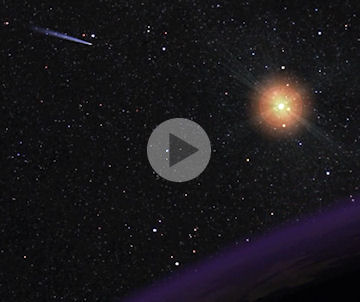ANDROID FLYBYS: Our field-tested satellite tracker is now available for Android phones. Features: Global predictions and flyby alarms! Learn more. | | | BIG LUNAR ECLIPSE: This Saturday morning, June 26th, there's going to be a lunar eclipse—and for many residents of the USA, it's going to be a big one. The eclipse will occur as the Moon is setting, causing the "Moon Illusion" to magnify the event to truly beautiful proportions. [full story] [eclipse gallery] SPACE STATION MARATHON: The International Space Station (ISS) is putting on a remarkable show. For the next few days, the behemoth spacecraft will be in constant sunlight as its orbit lines up with Earth's day-night terminator. This means it will shine brightly in the night sky every single time it passes overhead. Some observers can see it 3, 4, even 5 times a night! Bill Cooke of the Marshall Space Flight Center has prepared a movie showing the simulated view from a sun-facing window on the ISS. Click to play: 
Note: The comet pictured in the movie is Comet McNaught (C/20099 R1)
"That was one complete orbit of the ISS on June 25th," says Cooke. "Note how the sun never sets. The sun will remain 'up'--and the ISS constantly illuminated--until Monday, June 28th." Meanwhile, back on Earth, the ISS could be flying over your house right now. Check the Simple Satellite Tracker for viewing times. Better yet, let your iPhone or Android guide you to the ISS. There's an app for that! more images: from Valentin Grigore of Targoviste, Romania; from Paco Bellido of Córdoba, Spain; from Chris Kotsiopoulos of Ikaria island, Greece; from Ralf Vandebergh of the Netherlands AURORAS FROM ABOVE: Have you ever wondered what auroras look like from above? Astronauts onboard the International Space Station found out on May 29th when they flew through a geomagnetic storm and witnessed this green ribbon snaking over the Indian Ocean: 
The bright display of Southern Lights was sparked by a solar coronal mass ejection (CME), which hit Earth's magnetic field and sparked a G1-class geomagnetic storm. On the other end of the planet, the same storm produced bright Northern Lights over Wisconsin, Minnesota and parts of Canada. Both poles were ringed in light at the same time. This isn't the first time astronauts have seen auroras underfoot. The shuttle has flown right through auroral curtains with no ill effects--other than time lost while the crew crowds around the window to stare.The ISS also turns out to be a wonderful platform for aurora watching. Next up: A solar wind stream is due to hit Earth's magnetic field on June 26th or 27th, possibly sparking a new round of geomagnetic activity. Sky watchers above and below should be alert for auroras. May 2010 Aurora Gallery
[previous Mays: 2008, 2005, 2004, 2003, 2002] [aurora alerts] | 
